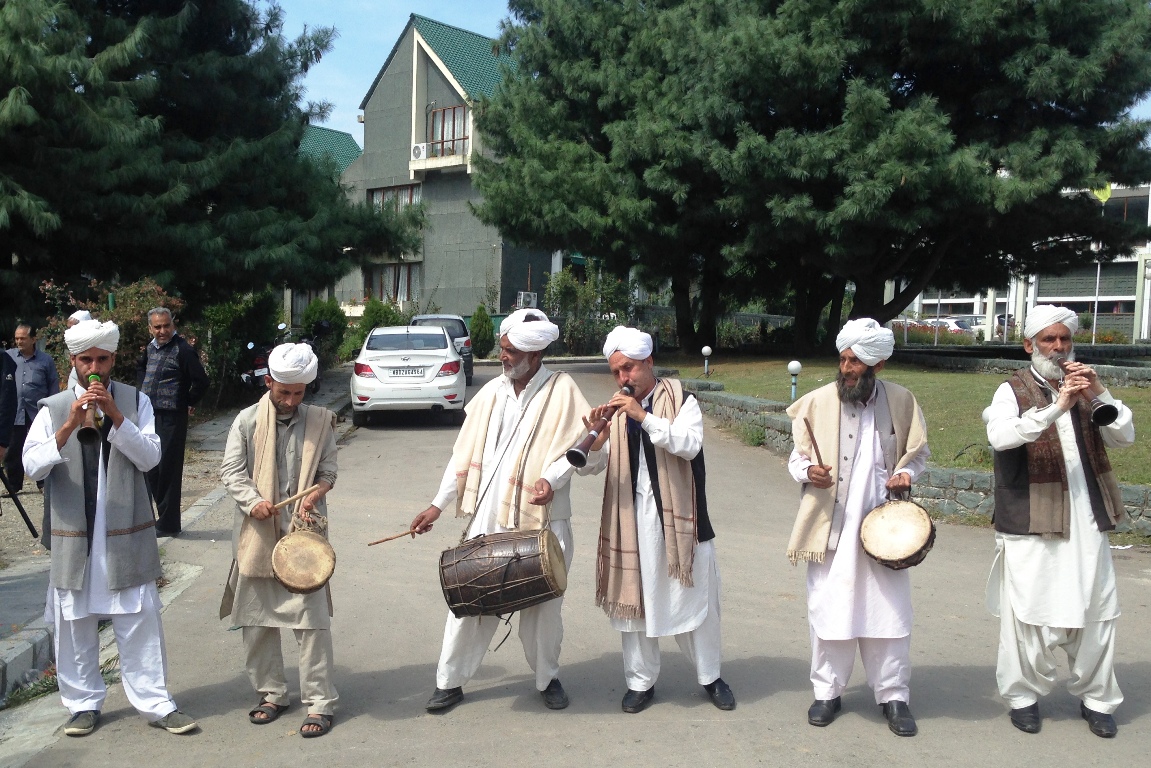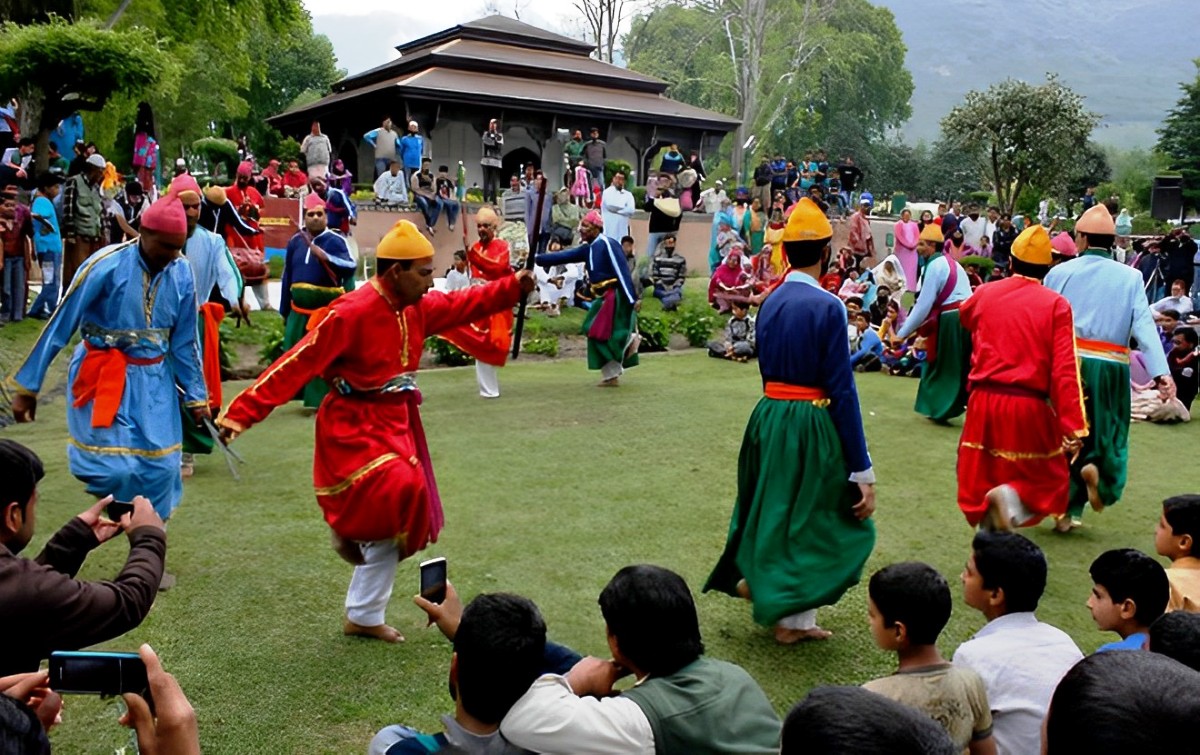Already restricted to a few villages in Kashmir, the traditional folk art practitioners insist that while paid performances have disappeared, they are lacking access to resources within the government set-up to preserve the art, reports Nida Meraj

A group of Baands would arrive in any Kashmir village dressed in vivid costumes, carrying instruments such as Daff, Surnai, a Kashmiri flute, drums and other musical instruments. With just one call to the people, everyone will know that these folk artists have arrived. A great throng of happy people and laughing youngsters would gather to watch their performance, the Baand Paether.
Kashmir has thriving music, a modest dance, and a slow-paced theatre culture. Baand Paether is an art form rooted in traditional folklore spanning over centuries. It was done in temples when female singers and dancers used to perform there. Later, it began to be done in shrines after Islam arrived. It was also performed in front of a large crowd on large fields.
Baand Paether has been derived from two Sanskrit terms Baand meaning historian and Paether meaning ‘playing horse’ or ‘one who replicates’. It refers to acting out, performing, or impersonating anything in front of an audience.
It is an ensemble of artists – singers, dancers and traditional instrument players. This art can be performed by a group of five or more artists. This can change according to the performance or the artists on stage. Baands are well-known for their use of wildly different and vivid costumes during their performances. They are required to wear these costumes in accordance with the roles they play. For a simple performance, they usually prefer a white pheran (Kashmir cloak) and a dastaar (turban).
Mostly Satire
Baand Paether mostly is satirical performances. They use humour to inform people about what is happening in their society. People, therefore, get informed about what is going on around them while also being entertained. Baand Paether has been classified into several types of Paethers such as Shikargah based on wildlife, Doikhaer Paether based on prayers and wishes, Angrez Paether based on foreigners, and Derze Paether, a symbolic reference to exploitative despots who ruled Kashmir. Derze is the name of pests that feed on crops.
“I have visited numerous Indian states and seen various traditional folk theatres. They mirror our Kashmiri folk theatre,” said Ghulam Mohiuddin Ajiz, 72, and one of the senior Baand Paether artist from Wathora (Budgam). “However, Baand Paether is incomparable to them because every one of our artists can act, play instruments, sing, and dance. But in other folk theaters, the voice is usually pre-recorded, artists are just lip-syncing and the person who plays instruments doesn’t usually act.”
The Baand Paether used to be performed spontaneously by artists in various locations they deemed fitting. Ajiz explained, “If we stumbled upon an event while walking, we would promptly engage in Baand Paether.” Their performances carried a genuine significance that resonated with people, yet they never caused harm or offended anyone’s sentiments.
Passion, Not Profession
In Kashmir, numerous artists who have mastered this art are now compelled to undertake manual labour to meet their families basic needs. “In the past, we used to perform multiple plays throughout the year and earn sufficient income for our families,” Mehrajuddin Bhagat, a 48-year-old artist currently working as a labourer, laments. “However, nowadays, we are fortunate to get even one performance annually.”

The two crippling waves of the Covid19 pandemic in 2020 and 2021 resulted in strict lockdown measures, preventing people from leaving their homes and prohibiting public gatherings. “We were unable to secure even the limited number of performances we used to have in a year,” admitted Mehraj.
The artists used to perform at dargahs and shrines during the Urs, specific days celebrating the death or birth of these revered saints, but unfortunately, this practice is diminishing. Those artists who can still pursue their craft now perform at schools and colleges on special occasions such as annual days, primarily for students.
Unfamiliar New Generation
Kashmir’s younger generation lacks familiarity with their folklore due to limited exposure. “To ensure the preservation of our folklore, my family and I take the initiative to educate children about it,” Shahi Jahan Bhagat, 37, an artist, said. “We organise short-duration workshops at our homes, usually spanning one to two months.” This endeavour aims to revive and sustain the essence of their cultural heritage.
Shahi stresses that preserving this folk art relies on artists actively engaging with and educating the public. However, these outreach efforts require financial support. “Even those familiar with the folklore struggle to find paid work,” he said. “How can we expect the younger generation to pursue this profession? Furthermore, their lack of awareness stems from our limited outreach.”
Students learning this art also acquire essential skills relevant to everyday life, such as body language, public speaking, podium etiquette, and overcoming stage fright. With this comprehensive training, they can fearlessly perform anywhere. However, the lack of funding prevents the expansion of training beyond the local village and district. “If artists receive funds and students are granted scholarships, we can easily train a larger number of students in this folk theatre,” Shahi emphasized.
While some Kashmiri artists have been fortunate to receive grants and fellowships from the Sangeet Natak Akademi and the Ministry of Culture, a significant number of artists are still unable to access these opportunities.
The Epicentre
Baand Paether is primarily preserved in Wathora (Budgam) and a few villages in Anantnag, mostly Badsgam, where artists receive central government funds. However, in other districts, Baand Paether has almost disappeared, compelling many artists to seek manual labour for their livelihoods.















